Your cart is currently empty!
How to Identify the Quality of a Wool Area Rug: Key Traits to Look For

When searching for a wool area rug, it’s important to know how to gauge its quality, as this affects both its aesthetic appeal and longevity. Wool rugs are prized for their natural durability, warmth, and resistance to dirt and stains. However, quality can vary widely, so it’s essential to examine certain indicators to ensure you’re getting a rug that’s both beautiful and built to last.
The knot count, or knots per square inch (KPSI), greatly impacts the definition and intricacy of the rug’s pattern. Generally, the higher the KPSI, the finer the design and the more durable the rug. Pile height also plays a role; low-pile rugs typically have longer lifespans, as they’re less prone to snagging and easier to clean. Remember, the feel of the rug underfoot and the evenness of the weave are tactile signs of a rug’s quality.
Key Takeaways
- Check the KPSI to assess the rug’s level of detail and durability.
- Opt for low-pile rugs for easier maintenance and higher resilience.
- A rug’s weave evenness and underfoot feel are indicative of its quality.
Understanding Wool as a Material
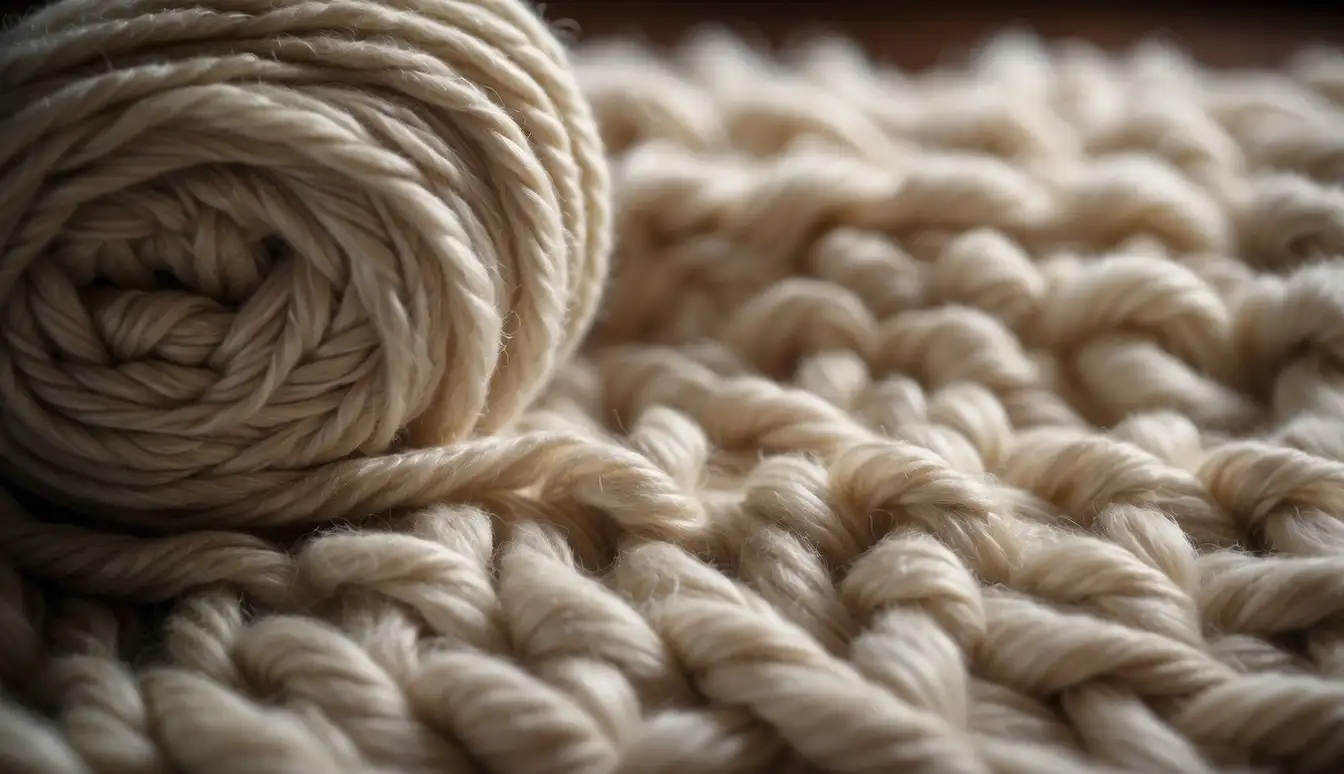
In exploring the quality of wool area rugs, you’ll find that the value is deeply connected to wool’s natural properties and origin. Wool offers unparalleled warmth and durability, making it a superior choice for rugs.
Origins of Wool
Wool is a natural fiber harvested from sheep and is renowned for its durability, warmth, and comfort. It’s an organic material that sheep regenerate every year, making it a sustainable resource. The quality of wool can vary depending on the breed of sheep and the conditions in which they are raised.
Benefits of Natural Fibers
Natural fibers like wool have several advantages over synthetic materials:
- Durability: Wool fibers can bend up to 20,000 times without breaking.
- Insulation: Wool naturally regulates temperature, keeping you warm in winter and cool in summer.
- Fire resistance: It’s naturally flame-retardant.
- Moisture-wicking: Wool can absorb moisture without feeling wet, helping to manage humidity.
- Hypoallergenic: Ideal for those with allergies as it resists dust mites, mold, and mildew.
Wool vs. Synthetic Materials
When comparing wool to synthetic fibers, consider:
- Feel: Wool is softer and more comfortable underfoot.
- Sustainability: Wool is a renewable resource; synthetics are often petroleum-based.
- Aging: Wool rugs age gracefully, developing a patina over time, while synthetic rugs can look worn.
- Environment: Wool is biodegradable, synthetics are not, and can take hundreds of years to degrade.
Remember, a rug’s longevity and resilience are influenced by the quality of the material. Wool’s natural properties make it a premium choice for area rugs in your home.
Key Factors in Rug Quality
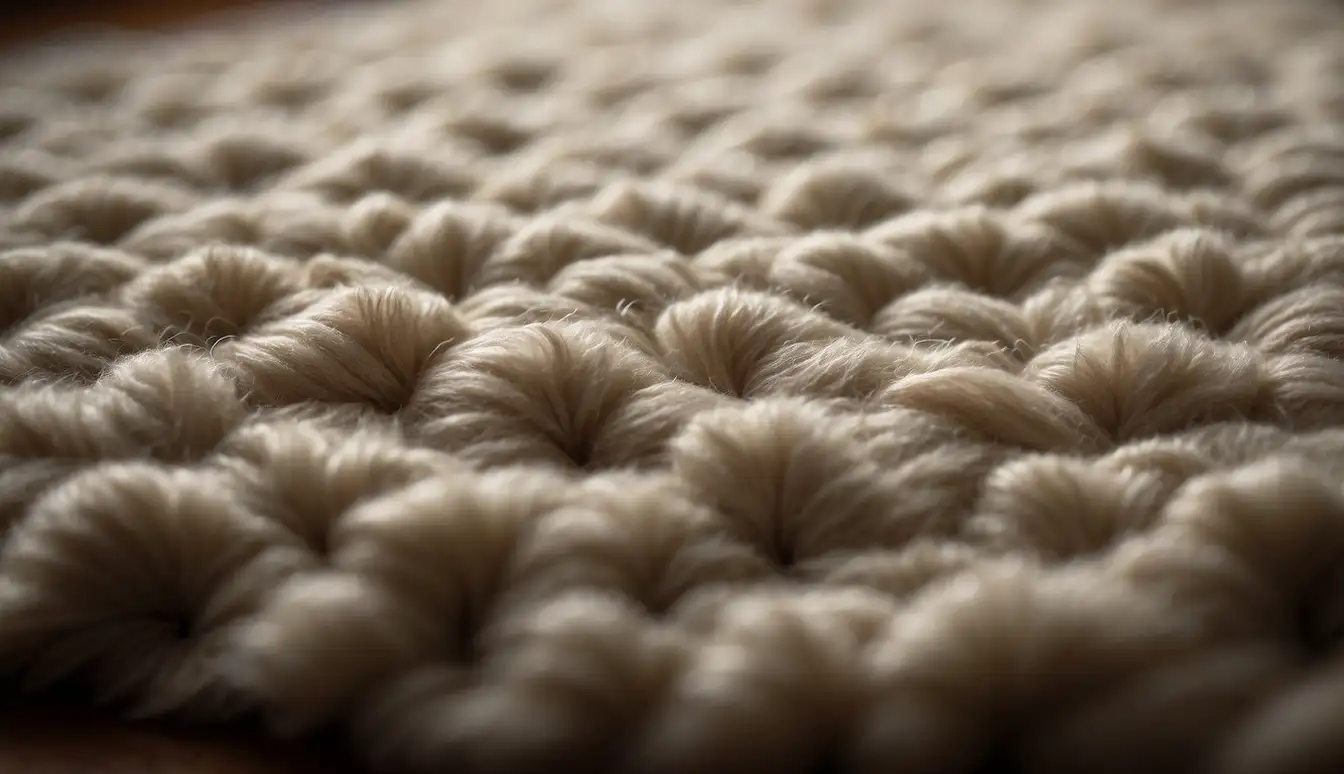
When determining the quality of a wool area rug, pay close attention to knot count, material quality, and weaving techniques. These three factors play pivotal roles in the rug’s overall durability, appearance, and value.
Assessing Knot Count
The knot count or knots per square inch (KPI) is a crucial metric in evaluating rug quality. Generally, a higher knot count indicates a finer weave and more detailed patterns. Here’s what you should look for:
- Hand-knotted rugs: Typically, high-quality rugs boast about 290 knots per square inch. To check, flip the rug and examine the underside.
- Oriental rugs: Renowned for their craftsmanship, they often have a dense knot count, contributing to their longevity and intricate designs.
Material Quality and Types
Rug durability and feel largely depend on the materials used. Wool rugs come in varying grades, influenced by the sheep breed and shearing process. Here are key points on materials:
- Natural dyes vs synthetic dyes: Rugs with natural dyes usually age better, developing a desirable patina.
- Quality grade: Feel the rug’s texture; a softer, more pliable feel typically suggests higher wool quality.
Differences in Weaving Techniques
Weaving techniques can greatly affect a rug’s quality. Here’s a brief comparison:
- Hand-knotted: Each knot is tied by hand, offering uniqueness and a long lifespan.
- Machine-made: Less labor-intensive and more uniform, but often not as durable as hand-made rugs.
Remember, these guidelines are meant to help you discern rug quality more effectively. Give each rug a thorough check to make your investment count.
Styles and Designs
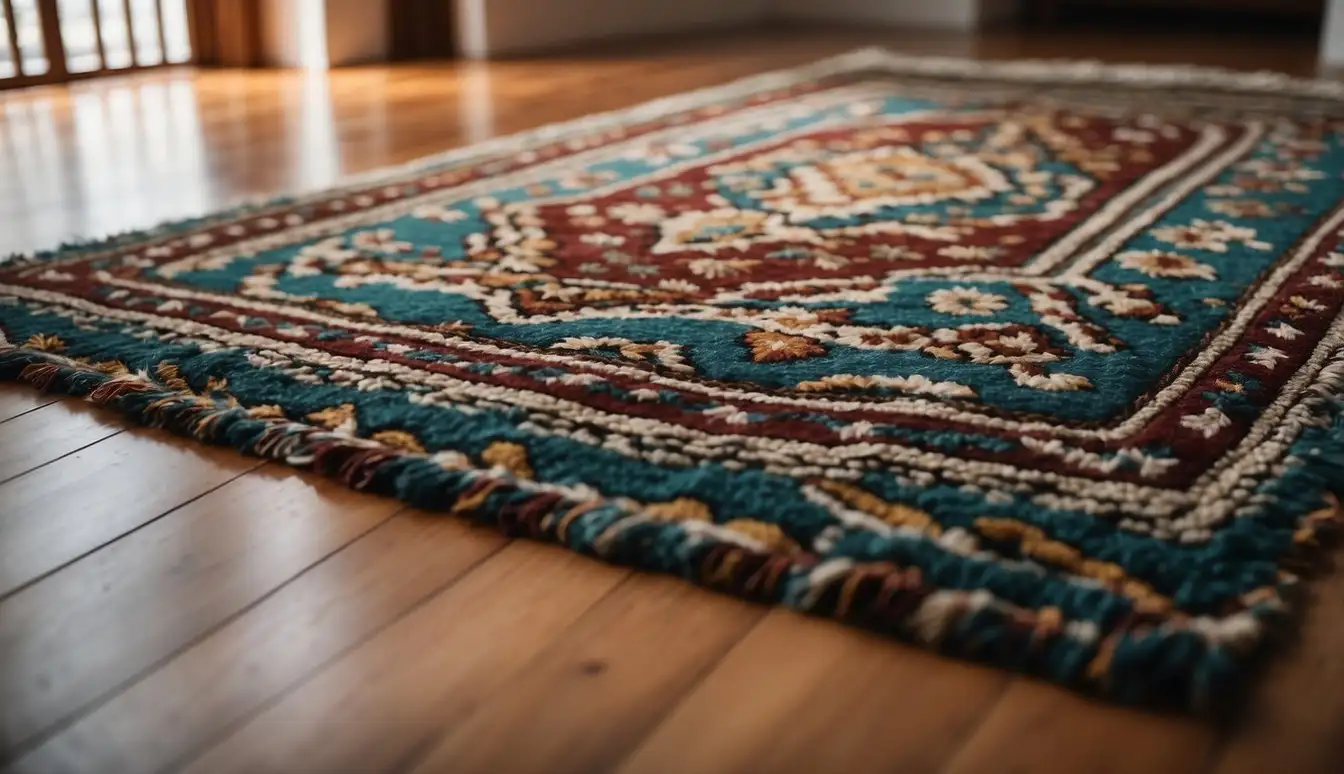
When exploring wool area rugs, the visual characteristics such as dye quality, pattern intricacy, and design style are essential indicators of a rug’s quality. These attributes not only contribute to the rug’s beauty but also to its value and uniqueness.
Color and Dyes
Your wool area rug’s colors come to life through the dyes used. Natural dyes are derived from plants, minerals, and in some cases insects, yielding a rich, fade-resistant palette. These natural colors tend to soften over time, developing a sought-after patina. On the other hand, synthetic dyes, which emerged in the late 19th century, offer a wider range of colors and consistency. Here are some specific details for you to consider:
- Natural dyes: Mellow over time and have variations in tone (abrash).
- Synthetic dyes: Maintain uniformity in color and are less prone to fading.
Patterns and Oriental Styles
Persian and Oriental rugs are renowned for their intricate designs, often featuring florals, medallions, and intricate border work. Persian rug motifs are usually denser in design and rich in history, with each pattern telling a story. Typically, high-quality Oriental rugs have a high knot count, which allows for this finer detail in pattern. Identify the styles by looking for:
- Floral and fauna motifs: Common in Persian and Oriental designs.
- Fine detail: Modeled in the rug’s intricate patterns and knot density.
Geometric and Modern Designs
Geometric and modern designs bring a contemporary edge to wool area rugs. These rugs may not require as high a knot count as traditional Oriental rugs, due to their simpler, bolder patterns. With a modern wool rug, keep an eye out for:
- Sharpness of pattern: Clear, defined lines point to careful craftsmanship.
- Design symmetry: Check for uniformity in geometric patterns, which demonstrates skilled weaving.
Remember, whether your rug is adorned with timeless Oriental motifs or bold modern designs, the clarity of the pattern and the colors used are key indicators of a quality wool area rug.
Construction and Durability
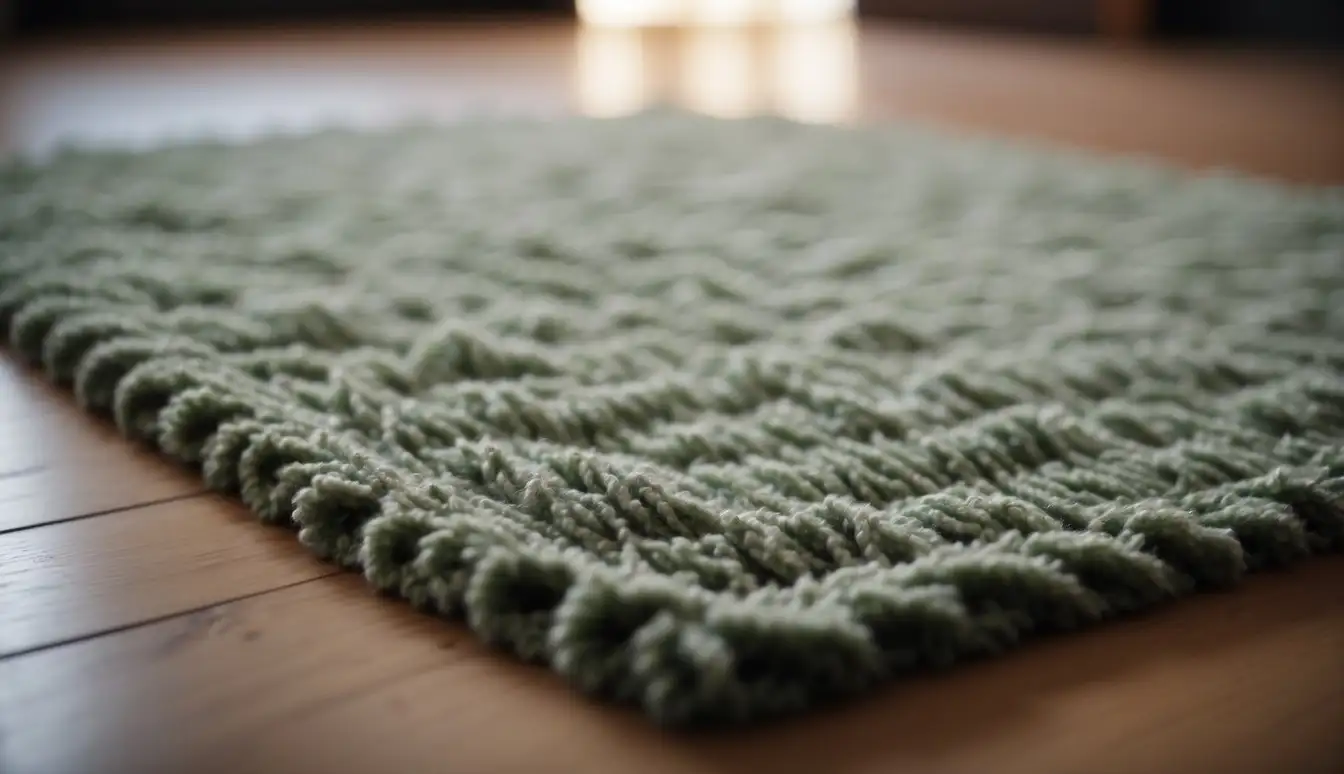
In the realm of wool area rugs, the quality significantly hinges on their construction and durability. Knowing whether your rug is handmade or machine-made, understanding the importance of pile height and density, and scrutinizing the binding and finishing can provide great insight into the longevity of your investment.
Handmade vs. Machine-Made Rugs
Handmade rugs are typically crafted through a labor-intensive process known as hand-knotting or hand-tufting. These handmade types are revered for their durability due to the intricate process of tying each knot by hand, a feature that can directly influence a rug’s lifespan. In contrast, machine-made rugs are produced rapidly on power looms, which can constrain their durability when compared to their handmade counterparts.
- Hand-Knotted: Each knot is individually tied by a skilled artisan, contributing to a rug’s uniqueness and resilience.
- Hand-Tufted: Involve the insertion of yarn into a backing that is then secured with a latex coating; they are robust but not as durable as hand-knotted rugs.
Pile Height and Density
The pile height refers to the length of the wool fibers, while density is determined by the number of knots per square inch. A higher density typically equates to a rug that’s more hard-wearing and able to retain its shape and design clarity over time.
- Low Pile: Rugs vary from flatweave to about a quarter inch high and are easier to clean, making them practical for high-traffic areas.
- High Pile: These are usually a half-inch or longer, feel more luxurious, yet may show footprints or furniture indentations more readily.
Binding and Finishing
A rug’s edges and the manner in which they are finished affect both its durability and overall aesthetic. Quality wool rugs often feature secure edges to prevent fraying and unraveling over time. Look for:
- Double-stitched or hand-serged edges, as these techniques generally indicate a durable finish.
- Evenly cut and well-secured fringe tassels, if present, as they contribute to the aesthetic without compromising the rug’s structure.
Area Rug Maintenance
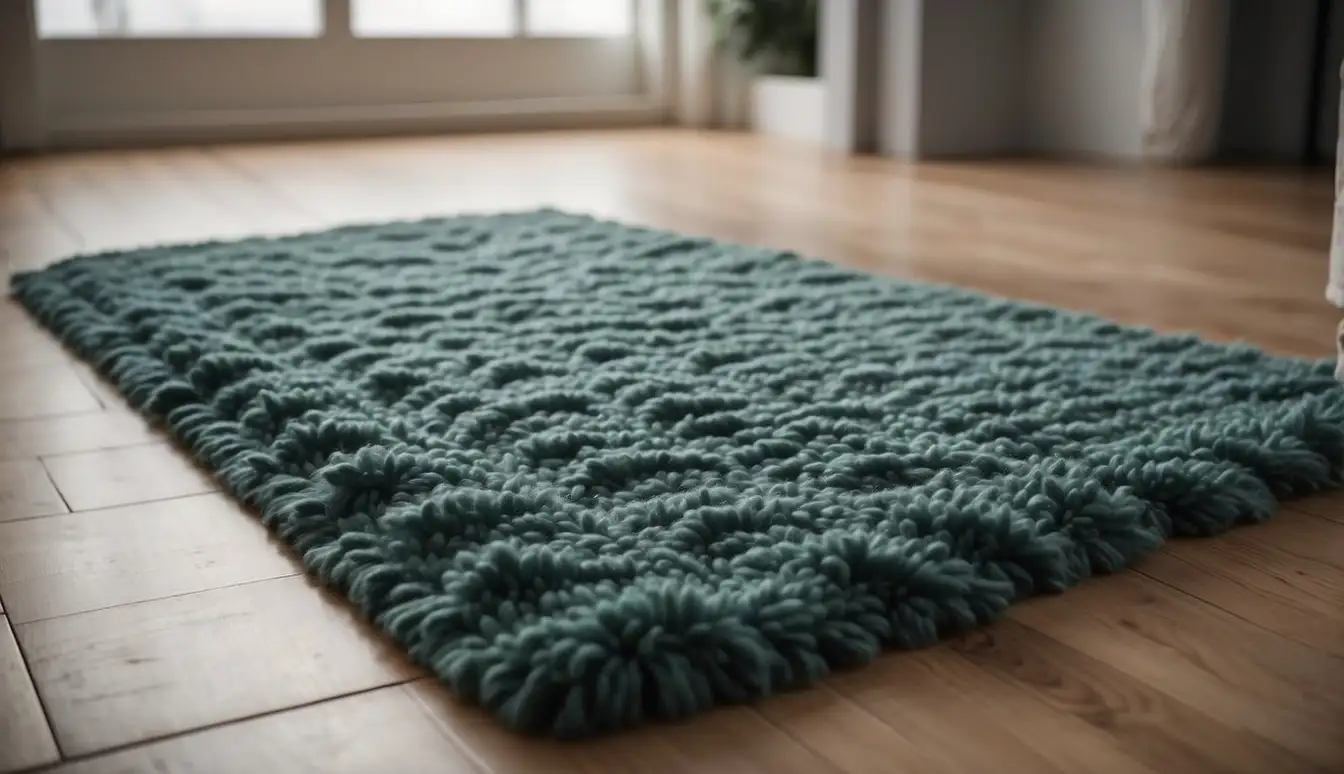
Maintaining your wool area rug is crucial to ensure its longevity and appearance. Proper cleaning and prompt stain management are key to keeping your area rug in top condition.
Cleaning and Care
To keep your wool area rug looking fresh, regular vacuuming is essential. Vacuum at least once a week to remove dust and dirt, which can wear down the rug fibers over time. For a deeper clean:
- Spot-treat stains with a gentle laundry detergent and warm water.
- If needed, use a wool-safe detergent and scrub lightly with a sponge.
- Rinse off the soap with a cloth and clean water.
- Blot dry the area with a towel to absorb moisture without rubbing.
Remember that wool rugs have natural stain resistance, but they still require gentle handling. Test cleaning products on a small, inconspicuous area before treating the entire rug.
Dealing with Pets and Stains
Pets can be tough on area rugs, but with quick action, you can manage pet-related stains effectively:
- For pet hair, use a vacuum with a brush attachment to lift fibers and remove hair.
- For accidents, immediately blot up as much as possible using a clean cloth, then follow up with a wool-safe cleaner.
- Address odors by lightly spraying a mixture of equal parts distilled white vinegar and water.
Remember to blot, not rub, when dealing with stains to prevent damage to the fibers of your area rug.
Considerations Before Purchase
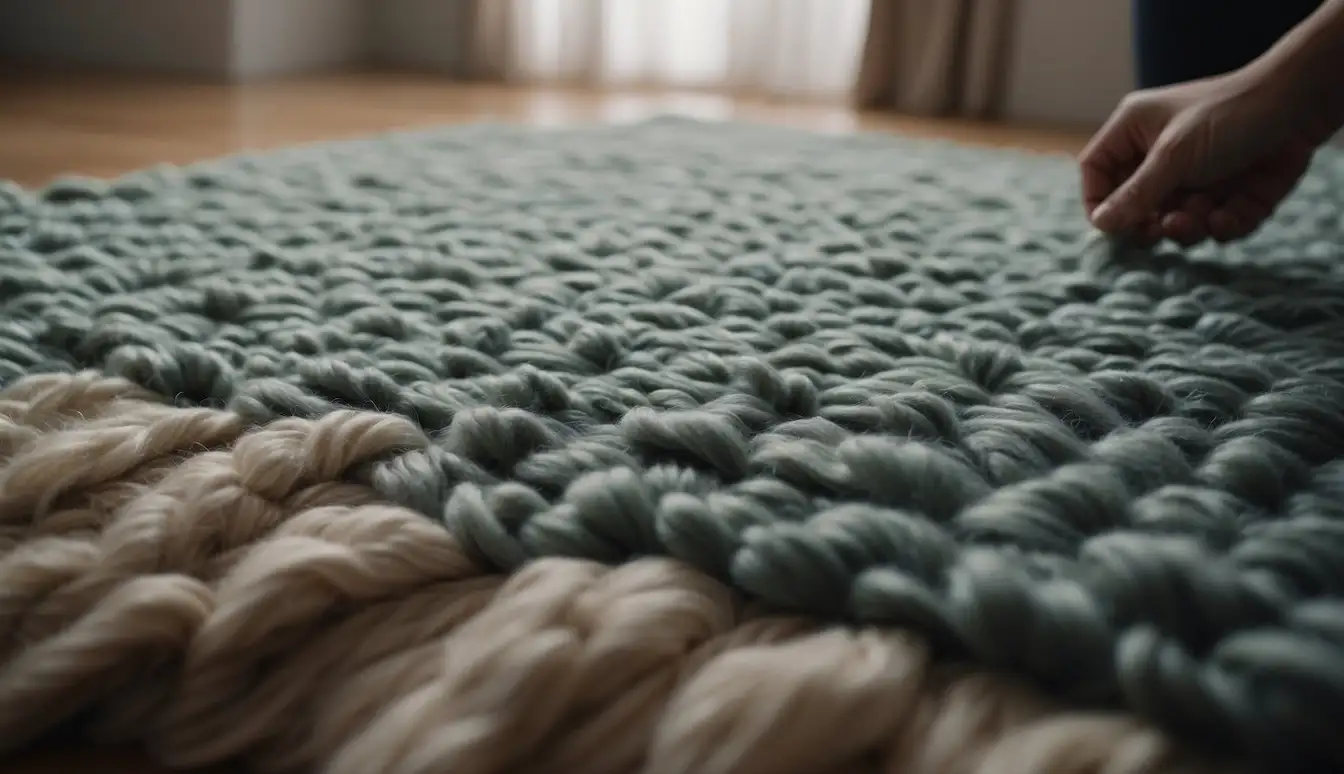
When looking to acquire a new wool area rug, it’s crucial for you to understand the factors that contribute to the rug’s longevity and suitability for your home. Let’s take a closer look at what you should consider in terms of cost, foot traffic, and authenticity before making your purchase.
Evaluating Cost and Lifespan
Cost:
- Budget-Friendly Option: Expect a good quality wool rug to come with a higher price tag compared to synthetic alternatives. However, don’t equate a high price with high quality blindly.
- Premium Investment: If you seek durability and a timeless piece, higher cost wool rugs often offer a longer lifespan, making them a wise investment over time.
Lifespan:
- If properly maintained, a high-quality wool rug can last for decades, providing both comfort and aesthetic appeal throughout its use.
Choosing Based on Foot Traffic
Foot Traffic Considerations:
- Low-Traffic Areas: A less dense wool rug could suffice for areas like bedrooms or studies.
- High-Traffic Areas: For spaces such as living rooms or hallways, choose a rug that boasts a higher knot count and density to withstand the wear and tear.
Unique Features and Authenticity
Unique Features:
- Look for signs of handcraftsmanship, which can include irregularities in patterns or slight color variations—these characteristics often add to a rug’s unique charm.
- Check for the material composition; authentic wool rugs should not release fibers readily when rubbed.
Authenticity:
- Understand the rug’s origin. Genuine oriental wool rugs have specific patterns and knot counts. Make sure to verify these details with the rug retailer, as they speak to the rug’s authenticity and quality.
Identifying High-Quality Wool Area Rugs
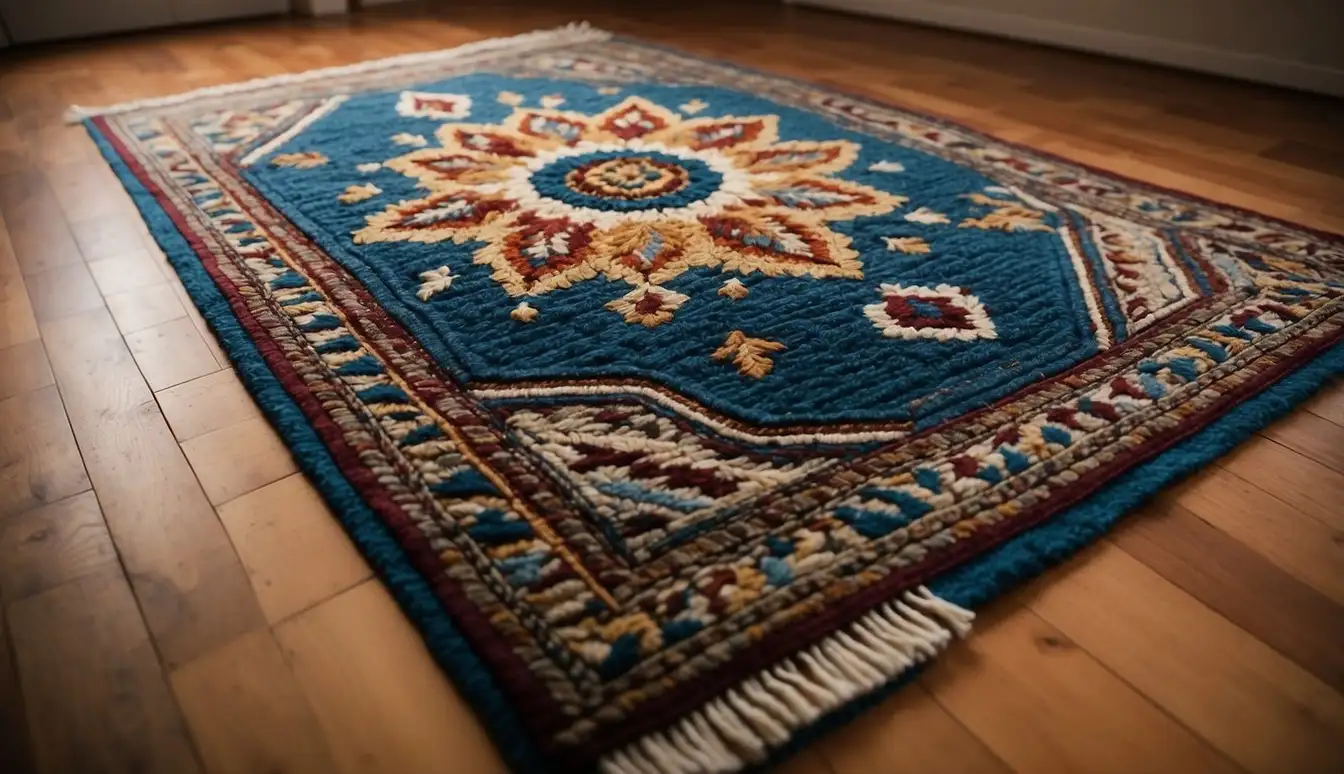
When you’re in the market for a high-quality wool area rug, particularly those handmade in renowned regions like India, Iran, and Pakistan, knowing what to look for can ensure that you invest wisely. Wool rugs from these areas are often prized for their craftsmanship and durability.
Knot Density: A key factor in determining rug quality is the number of knots per square inch (KPSI). High-quality rugs typically have a KPSI of 290 or more, which contributes to the rug’s durability and the clarity of its design.
- Low KPSI: 50-150
- Medium KPSI: 150-290
- High KPSI: 290 or more
Pile Height: The height of the rug’s fibers affects its longevity and suitability for various levels of foot traffic.
| Pile Type | Characteristics |
|---|---|
| Low Pile | Durable, easy to clean, less likely to snag |
| Medium Pile | Balance of comfort and easy maintenance |
| High Pile | Plush and comfortable, best for low traffic areas |
Material Quality: The wool used in high-quality rugs should feel resilient and springy to the touch, indicating that it’s less likely to wear down or stain. Rub your hand firmly against the pile; if the fibers spring back, it’s a good sign.
Fringe: The fringe should be an extension of the rug’s structure, not glued or sewn on, which is a sign of a handmade oriental rug.
By keeping these factors in mind, you can make an informed decision and select a wool area rug that not only looks beautiful but also stands the test of time.
Factors Affecting Pricing and Value
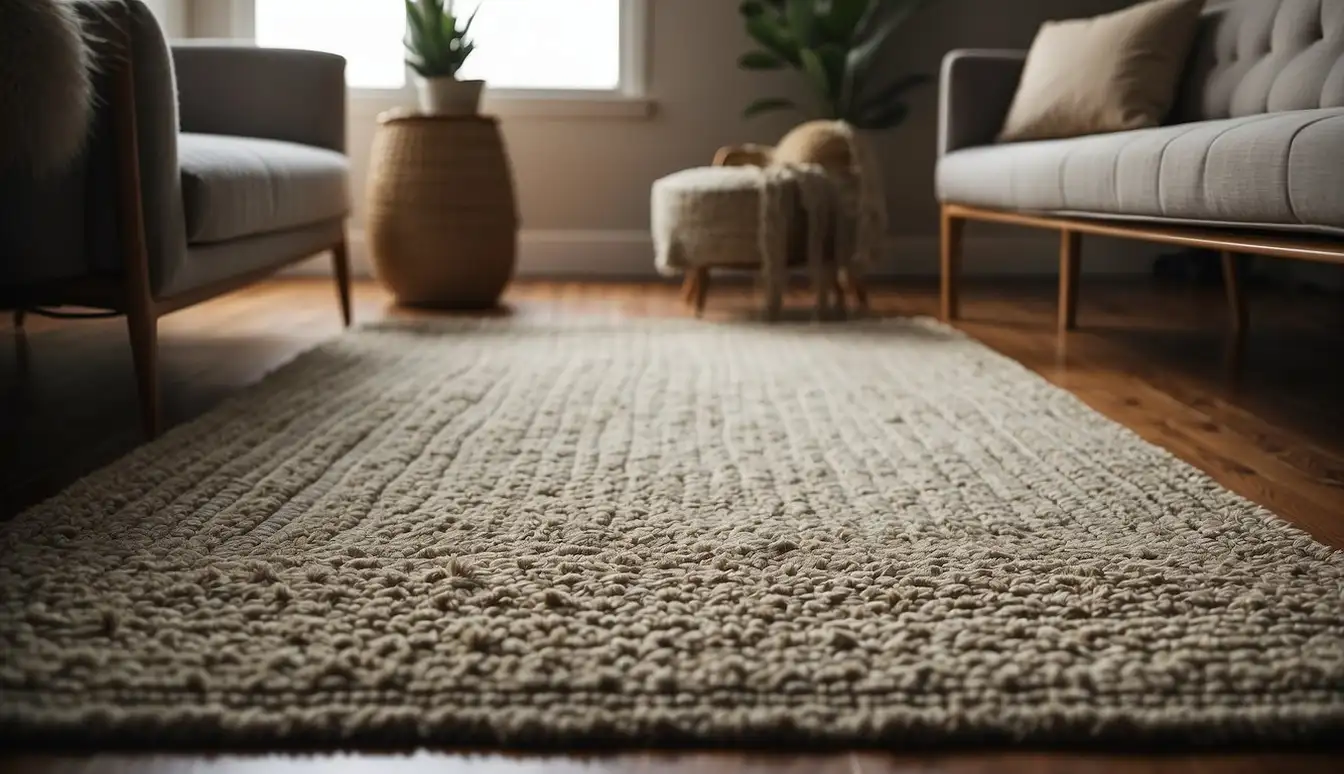
When you’re evaluating wool area rugs, two critical aspects that significantly influence their pricing and value are the sourcing of the materials and the labor that goes into their creation.
Material Sourcing and Labor
High-quality wool area rugs often use materials like silk and fine wool, which can be costly due to their sourcing and preparation. The yarn used in these rugs comes from different breeds of sheep, and in the case of silk, from the cocoons of silkworms. The origin of the materials can add to the cost, especially if they’re rare or organically sourced.
The labor behind hand-made rugs is extensive. Each rug requires countless hours of skilled artisan’s work, making labor a significant component of the final cost. Hand-knotted rugs, for instance, can take a single weaver several months to complete. Cotton foundations are also common in many hand-made rugs, further impacting the labor intensity and thus the pricing due to the care needed in weaving these materials together.
Comparison: Hand-Made vs. Mass-Produced
-
Hand-Made Wool Rugs
- Made with individual care and often in a traditional method.
- Labor: Skilled artisans take months or even years to create a single rug.
- Cost: More expensive due to the intricate work and time investment.
-
Mass-Produced Wool Rugs
- Typically manufactured using machines, reducing the time needed for production.
- Labor: Less labor-intensive, often involving minimal human intervention.
- Cost: Generally cheaper because of automated processes and economies of scale.
The decision between hand-made and mass-produced ultimately affects the rug’s aesthetic quality, durability, and value. Hand-made rugs are prized for their uniqueness and craftsmanship, which is reflected in their price, whereas mass-produced rugs offer practicality and affordability.
Frequently Asked Questions
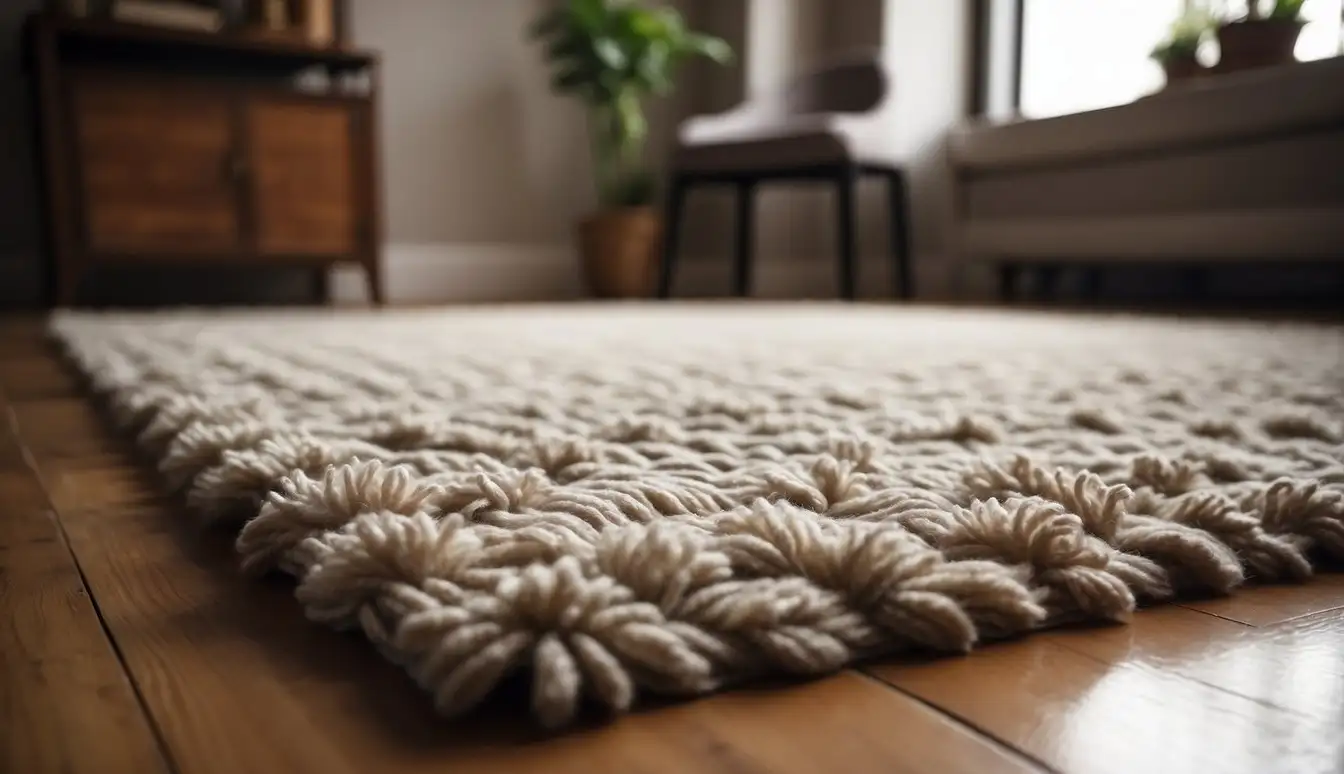
Assessing the quality of a wool area rug can be quite straightforward if you know what signs to look for. Let’s address some common inquiries to help guide your evaluation.
How can one determine if an area rug is made of genuine wool?
To confirm if an area rug is made of real wool, you can check for a soft and plush texture. Genuine wool is also flame resistant, so a quick match test (taking a small tuft of fibers and burning them) can indicate authenticity; wool will smell like burnt hair and extinguish itself.
What are the indicators of high quality in oriental rugs?
High-quality oriental rugs often have a high knot count per square inch (KPSI), with elaborate patterns and detailed curvilinear designs. Typically, a KPSI ranging between 120-350 is considered good, while very high-quality rugs might have 400 KPSI or more.
What characteristics distinguish a handmade rug from mass-produced ones?
Handmade rugs showcase unique design intricacies and slight variances in patterns, reflecting the weaver’s craftsmanship. The backside of the rug should display the same vivid pattern as the front, a sign of the meticulous knotting process, unlike the less distinct patterns found on machine-made counterparts.
What factors contribute to a rug appearing inexpensive or luxurious?
The materials used, knot density, finishing, and overall complexity of the design contribute to the perception of a rug’s value. Luxurious rugs often feature fine wool, high knot count, and rich, abiding dyes that create depth and elegance in the design.
What criteria should be considered when selecting a high-quality area rug?
When selecting a high-quality area rug, consider the knot count, the clarity of the design, the quality of the wool, and dye. A tightly woven rug with high knot density and a clear design is an indicator of superior craftsmanship.
What are the signs that a Persian rug is of superior quality?
Persian rugs of superior quality usually possess a tight, even weave, high knot count, and saturated, natural dyes that resist fading. The rug should feel balanced and heavy in hand, and intricate patterns should be crisp and clearly delineated.
